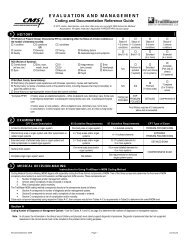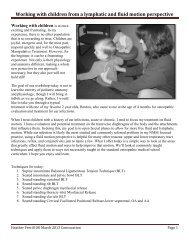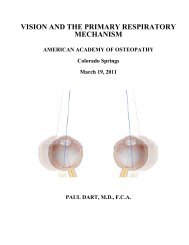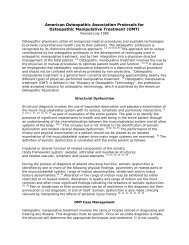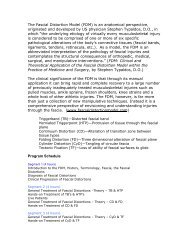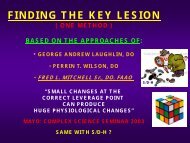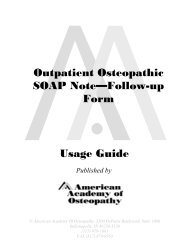AOA Position Paper on Osteopathic Manipulation Treatment of the ...
AOA Position Paper on Osteopathic Manipulation Treatment of the ...
AOA Position Paper on Osteopathic Manipulation Treatment of the ...
- No tags were found...
You also want an ePaper? Increase the reach of your titles
YUMPU automatically turns print PDFs into web optimized ePapers that Google loves.
American <strong>Osteopathic</strong> Associati<strong>on</strong><str<strong>on</strong>g>Positi<strong>on</strong></str<strong>on</strong>g> <str<strong>on</strong>g>Paper</str<strong>on</strong>g> <strong>on</strong> <strong>Osteopathic</strong> Manipulati<strong>on</strong> <strong>Treatment</strong><strong>of</strong> <strong>the</strong> Cervical SpineBackground and Statement <strong>of</strong> IssueThere has recently been an increasing c<strong>on</strong>cern about <strong>the</strong> safety <strong>of</strong> cervical spine manipulati<strong>on</strong>. Specifically, this c<strong>on</strong>cern hascentered <strong>on</strong> devastating negative outcomes such as stroke. This paper will present <strong>the</strong> evidence behind <strong>the</strong> benefit <strong>of</strong> cervicalspine manipulati<strong>on</strong>, explore <strong>the</strong> potential harm and make a recommendati<strong>on</strong> about its use.BenefitSpinal manipulati<strong>on</strong> has been reviewed in meta-analysis published as early as 1992, showing a clear benefit for low back pain. 1There is less available informati<strong>on</strong> in <strong>the</strong> literature about manipulati<strong>on</strong> in regards to neck pain and headache, but <strong>the</strong> evidencedoes show benefit. 2,3,4,5,6 There have been at least 12 randomized c<strong>on</strong>trolled trials <strong>of</strong> manipulative treatment <strong>of</strong> neck pain.Some <strong>of</strong> <strong>the</strong> benefits shown include relief <strong>of</strong> acute neck pain, reducti<strong>on</strong> in neck pain as measured by validated instruments insub-acute and chr<strong>on</strong>ic neck pain compared with muscle relaxants or usual medical care. There is also short-term relief fromtensi<strong>on</strong>-type headaches. 7 Manipulati<strong>on</strong> relieves cervicogenic headache and is comparable to comm<strong>on</strong>ly used first line prophylacticprescripti<strong>on</strong> medicati<strong>on</strong>s for tensi<strong>on</strong>-type headache and migraine. 8 Meta-analysis <strong>of</strong> 5 randomized c<strong>on</strong>trolled trialsshowed that <strong>the</strong>re was a statistically significant reducti<strong>on</strong> in neck pain using a visual analogue scale. 9HarmSince 1925, <strong>the</strong>re have been approximately 275 cases <strong>of</strong> adverse events reported with cervical spine manipulati<strong>on</strong>. 10 ,11 ,12 , 13 Ithas been suggested by some that <strong>the</strong>re is an under-reporting <strong>of</strong> adverse events. 10 A c<strong>on</strong>servative estimate <strong>of</strong> <strong>the</strong> number <strong>of</strong>cervical spine manipulati<strong>on</strong>s per year is approximately 33 milli<strong>on</strong> and may be as high as 193 milli<strong>on</strong> in <strong>the</strong> US and Canada.The estimated risk <strong>of</strong> adverse outcome following cervical spine manipulati<strong>on</strong> ranges from 1 in 400,000 to 1 in 3.85 milli<strong>on</strong>manipulati<strong>on</strong>s. 16 , 17 ,18 ,19 The estimated risk <strong>of</strong> major impairment following cervical spine manipulati<strong>on</strong> is 6.39 per 10 milli<strong>on</strong>manipulati<strong>on</strong>s. 20Most <strong>of</strong> <strong>the</strong> reported cases <strong>of</strong> adverse outcome have involved “Thrust” or “High Velocity/Low Amplitude” types <strong>of</strong> manipulativetreatment. 11 Many <strong>of</strong> <strong>the</strong> reported cases do not distinguish <strong>the</strong> type <strong>of</strong> manipulative treatment provided. However, <strong>the</strong> risk <strong>of</strong> avertebrobasilar accident (VBA) occurring sp<strong>on</strong>taneously, is nearly twice <strong>the</strong> risk <strong>of</strong> a VBA resulting from cervical spine manipulati<strong>on</strong>.7 This includes cases <strong>of</strong> ischemic stroke and vertebral artery dissecti<strong>on</strong>.A c<strong>on</strong>cern has been raised by a recent report that VBA following cervical spine manipulati<strong>on</strong> is unpredictable. 10 This report isbiased because all <strong>of</strong> <strong>the</strong> cases were involved in litigati<strong>on</strong>.The nature <strong>of</strong> litigati<strong>on</strong> can lead to inaccurate reporting by patient or provider. However, it did c<strong>on</strong>clude that VBA followingcervical spine manipulati<strong>on</strong> is “idiosyncratic and rare”. Fur<strong>the</strong>r review <strong>of</strong> this data showed that 25% <strong>of</strong> <strong>the</strong> cases presentedwith sudden <strong>on</strong>set <strong>of</strong> new and unusual headache and neck pain <strong>of</strong>ten associated with o<strong>the</strong>r neurologic symptoms that mayhave represented a dissecti<strong>on</strong> in progress. 21In direct c<strong>on</strong>trast to this c<strong>on</strong>cern <strong>of</strong> unpredictability, ano<strong>the</strong>r recent report states that cervical spine manipulati<strong>on</strong> may worsenpreexisting cervical disc herniati<strong>on</strong> or even cause cervical disc herniati<strong>on</strong>. This report describes complicati<strong>on</strong>s such as radiculopathy,myelopathy, and vertebral artery compressi<strong>on</strong> by a lateral cervical disc herniati<strong>on</strong>. 12 The authors c<strong>on</strong>cluded that <strong>the</strong>incidence <strong>of</strong> <strong>the</strong>se types <strong>of</strong> complicati<strong>on</strong>s could be lessened by rigorous adherence to published exclusi<strong>on</strong> criteria for cervicalspine manipulati<strong>on</strong>. 12 The current literature does not clearly distinguish <strong>the</strong> type <strong>of</strong> provider (i.e. M.D., D.O., D.C. or P.T.)or manipulative treatment (manipulati<strong>on</strong> vs mobilizati<strong>on</strong>) provided in cases associated with VBA. This informati<strong>on</strong> may helpto understand <strong>the</strong> mechanism <strong>of</strong> injury leading to VBA, as <strong>the</strong>re are differences in educati<strong>on</strong> and practice am<strong>on</strong>g <strong>the</strong> variouspr<strong>of</strong>essi<strong>on</strong>s that utilize this type <strong>of</strong> treatment.Comparis<strong>on</strong> <strong>of</strong> Alternative <strong>Treatment</strong>sNSAIDs are <strong>the</strong> most comm<strong>on</strong>ly prescribed medicati<strong>on</strong>s for neck pain. Approximately 13 milli<strong>on</strong> Americans use NSAIDs regularly.32 81% <strong>of</strong> GI bleeds related to NSAID use occur without prior symptoms. 32 Research in <strong>the</strong> United Kingdom has shown NSAIDswill cause 12,000 emergency admissi<strong>on</strong>s and 2,500 deaths per year due to GI tract complicati<strong>on</strong>s. 22 The annual cost <strong>of</strong> GI tract23 ,24 ,complicati<strong>on</strong>s in <strong>the</strong> US is estimated at $3.9 billi<strong>on</strong>, with up to 103,000 hospitalizati<strong>on</strong>s and at least 16,500 deaths per year.32This makes GI toxicity from NSAIDs <strong>the</strong> 15 th most comm<strong>on</strong> cause <strong>of</strong> death in <strong>the</strong> United States. 32Epidural steroid injecti<strong>on</strong> is a popular treatment for neck pain. Comm<strong>on</strong> risks include subdural injecti<strong>on</strong>, intra<strong>the</strong>cal injecti<strong>on</strong>and intravascular injecti<strong>on</strong>. 35 Subdural injecti<strong>on</strong> occurs in ~ 1% <strong>of</strong> procedures. 35 Intra<strong>the</strong>cal injecti<strong>on</strong> occurs in ~ 0.6-10.9% <strong>of</strong>procedures. 35 Intravascular injecti<strong>on</strong> is <strong>the</strong> most significant risk and occurs in ~ 2% <strong>of</strong> procedures and ~ 8% <strong>of</strong> procedures inpregnant patients. 35 Cervical epidural abscess is rare, but has been reported in <strong>the</strong> literature. 3614 ,15
Provocative TestsProvocative tests such as <strong>the</strong> DeKline test have been studied in animals and humans. This test and o<strong>the</strong>rs like it were found to25 ,26 ,27 ,28 ,29 ,30be unreliablefor dem<strong>on</strong>strating reproducibility <strong>of</strong> ischemia or risk <strong>of</strong> injuring <strong>the</strong> vertebral artery.Risk factorsVBA accounts for 1.3 in 1000 cases <strong>of</strong> stroke, making this a rare event. Approximately 5% <strong>of</strong> patients with VBA die as a result,while 75% have a good functi<strong>on</strong>al recovery. 33 The most comm<strong>on</strong> risk factors for VBA are migraine, hypertensi<strong>on</strong>, oral c<strong>on</strong>traceptiveuse and smoking. 31 Elevated homocysteine levels, which have been implicated in cardiovascular disease, may be a riskfactor for VBA. 34A study d<strong>on</strong>e in 1999 reviewing 367 cases <strong>of</strong> VBA reported from 1966-1993 showed 115 cases related to cervical spine manipulati<strong>on</strong>;167 were sp<strong>on</strong>taneous, 58 from trivial trauma and 37 from major trauma. 31Complicati<strong>on</strong>s from cervical spine manipulati<strong>on</strong> most <strong>of</strong>ten occur in patients who have had prior manipulati<strong>on</strong> uneventfullyand without obvious risk factors for VBA. 7 “Most vertebrobasilar artery dissecti<strong>on</strong>s occur in <strong>the</strong> absence <strong>of</strong> cervical manipulati<strong>on</strong>,ei<strong>the</strong>r sp<strong>on</strong>taneously or after trivial trauma or comm<strong>on</strong> daily movements <strong>of</strong> <strong>the</strong> neck, such as backing out <strong>of</strong> <strong>the</strong> driveway,painting <strong>the</strong> ceiling, playing tennis, sneezing, or engaging in yoga exercises.” 10 In some cases manipulati<strong>on</strong> may not be <strong>the</strong>primary insult causing <strong>the</strong> dissecti<strong>on</strong>, but an aggravating factor or coincidental event. 21It has been proposed that thrust techniques that use a combinati<strong>on</strong> <strong>of</strong> hyperextensi<strong>on</strong>, rotati<strong>on</strong> and tracti<strong>on</strong> <strong>of</strong> <strong>the</strong> upper cervicalspine will place <strong>the</strong> patient at greatest risk <strong>of</strong> injuring <strong>the</strong> vertebral artery. In a retrospective review <strong>of</strong> 64 medical legalcases, informati<strong>on</strong> <strong>on</strong> <strong>the</strong> type <strong>of</strong> manipulati<strong>on</strong> was available in 39 (61%) <strong>of</strong> <strong>the</strong> cases. 51% involved rotati<strong>on</strong>, with <strong>the</strong> remaining49% representing a variety <strong>of</strong> positi<strong>on</strong>s including lateral flexi<strong>on</strong>, tracti<strong>on</strong> and isolated cases <strong>of</strong> n<strong>on</strong>-force or neutral positi<strong>on</strong>thrusts. Only 15% reported any form <strong>of</strong> extensi<strong>on</strong> 21C<strong>on</strong>clusi<strong>on</strong><strong>Osteopathic</strong> manipulative treatment <strong>of</strong> <strong>the</strong> cervical spine, including but not limited to High Velocity/Low Amplitude treatment,is effective for neck pain and is relatively safe, especially in comparis<strong>on</strong> to o<strong>the</strong>r comm<strong>on</strong> treatments. Because <strong>of</strong> <strong>the</strong> very smallrisk <strong>of</strong> adverse outcomes, trainees should be provided with sufficient informati<strong>on</strong> so <strong>the</strong>y are advised <strong>of</strong> <strong>the</strong> potential risks.There is a need for research to distinguish <strong>the</strong> risk <strong>of</strong> VBA associated with manipulati<strong>on</strong> d<strong>on</strong>e by provider type and to determine<strong>the</strong> nature <strong>of</strong> <strong>the</strong> relati<strong>on</strong>ship between different types <strong>of</strong> manipulative treatment and VBA.Therefore, it is <strong>the</strong> positi<strong>on</strong> <strong>of</strong> <strong>the</strong> American <strong>Osteopathic</strong> Associati<strong>on</strong> that all modalities <strong>of</strong> osteopathic manipulative treatment<strong>of</strong> <strong>the</strong> cervical spine, including High Velocity/Low Amplitude, should c<strong>on</strong>tinue to be taught at all levels <strong>of</strong> educati<strong>on</strong>, and thatosteopathic physicians should c<strong>on</strong>tinue to <strong>of</strong>fer this form <strong>of</strong> treatment to <strong>the</strong>ir patients.Adopted by <str<strong>on</strong>g>AOA</str<strong>on</strong>g> House <strong>of</strong> Delegates July 14, 20051Shekelle, P, Adams, A, et al. Spinal manipulati<strong>on</strong> for low-back pain. Annals <strong>of</strong> Internal Medicine 1992;117(7): 590-98.2Koes, BW, Bouter, LM, et al. The effectiveness <strong>of</strong> manual <strong>the</strong>rapy, physio<strong>the</strong>rapy, and treatment by <strong>the</strong> general practiti<strong>on</strong>er for n<strong>on</strong>specificback and neck complaints, a randomized clinical trial. Spine 1992;17(1):28-35.3Koes, B, Bouter, L, et al. Randomised clinical trial <strong>of</strong> manipulative <strong>the</strong>rapy and physio<strong>the</strong>rapy for persistent back and neck complaints:results <strong>of</strong> <strong>on</strong>e year follow up. BMJ 1992;304:601-5.4Koes BW, Bouter LM van Marmeren H, et al. A randomized clinical trial <strong>of</strong> manual <strong>the</strong>rapy and physio<strong>the</strong>rapy for persistent neck and backcomplaints: sub-group analysis and relati<strong>on</strong>ship between outcome measures. J Manipulative Physio Ther 1993;16:211-9.5Cassidy JD, Lopes AA, Y<strong>on</strong>g-Hing K. The immediate effect <strong>of</strong> manipulati<strong>on</strong> versus mobilizati<strong>on</strong> <strong>on</strong> pain and range <strong>of</strong> moti<strong>on</strong> in <strong>the</strong> cervicalspine: A randomized c<strong>on</strong>trolled trial. J Manipulative Physio Ther 1992;15: 570-5.6Jensen OK, Nielsen FF, Vosmar L. An open study comparing manual <strong>the</strong>rapy with <strong>the</strong> use <strong>of</strong> cold packs in <strong>the</strong> treatment <strong>of</strong> posttraumaticheadache. Cephalgia 1990;10:241-50.7Hurwitz EL, Aker PD, Adams AH, Meeker WC, et al. Manipulati<strong>on</strong> and Mobilizati<strong>on</strong> <strong>of</strong> <strong>the</strong> Cervical Spine. A systematic review <strong>of</strong> <strong>the</strong> literature.Spine 1996; 21(15):1746-56 .8Br<strong>on</strong>fort G, Assendelft WJ, Evans R, Haas M, Bouter. Efficacy <strong>of</strong> spinal manipulati<strong>on</strong> for chr<strong>on</strong>ic headache: a systematic review. J <strong>of</strong> Manip &Physio Ther 2001;27(7):457-66.9Gross AR, Aker PD, Goldsmith CH, Peloso P. C<strong>on</strong>servative management <strong>of</strong> mechanical neck disorders. A systematic overview and meta-analysis.Online J Curr Clin Trials. 1996; Doc No 200-201.10Haldeman S, Kohlbeck FJ and McGregor M. Unpredictabilty <strong>of</strong> cerebrovascular ischemia associated with cervical spine manipulati<strong>on</strong>: Areview <strong>of</strong> 64 cases after cervical spine manipulati<strong>on</strong> <strong>the</strong>rapy. Spine 2002;27:49-55.11Assendelft WJJ, Bouter LM and Knipschild PG. Complicati<strong>on</strong>s <strong>of</strong> spinal manipulati<strong>on</strong>: A comprehensive review <strong>of</strong> <strong>the</strong> literature. J Fam Pract1996; 42: 475-480.12Mal<strong>on</strong>e DG, Baldwin NG, Tomecek FJ, Boxell CM, et al. Complicati<strong>on</strong>s <strong>of</strong> cervical spine manipulati<strong>on</strong> <strong>the</strong>rapy: 5-Year retrospective study in asingle-group practice.Neurosurg Focus 13(6), 2002.13Vick DA, McKay C, Zengerle CR. The safety <strong>of</strong> manipulative treatment: review <strong>of</strong> <strong>the</strong> literature from 1925 to 1993. J<str<strong>on</strong>g>AOA</str<strong>on</strong>g> 1996; 96(2):113-5.14Haldeman S, Carey P, Townsend M, Papadopoulos C. Arterial dissecti<strong>on</strong> following cervical manipulati<strong>on</strong>. The chiropractic experience. CMAJ2001;165: 905-6.
15Hurwitz EL, Coulter ID, Adams AH, Genovese BJ, Shekelle PG. Use <strong>of</strong> chiropractic services from 1985 through 1991 in <strong>the</strong> United States andCanada. Am J Public Health 1998;88:771-6.16Jens<strong>on</strong> et al. Complicati<strong>on</strong>s <strong>of</strong> cervical manipulati<strong>on</strong>, General ForensicScience 1987 ; 32(4) :1089-1094.17Koss RW. Quality assurance m<strong>on</strong>itoring <strong>of</strong> osteopathic manipulative treatment. J<str<strong>on</strong>g>AOA</str<strong>on</strong>g> 1990;90(5):427-433.18Dvorak J, Orelli F. How dangerous is manipulati<strong>on</strong> to <strong>the</strong> cervical spine? Case report and results <strong>of</strong> a survey. Manual Med 1985;2:1-4.19Carey P. A report <strong>on</strong> <strong>the</strong> occurrence <strong>of</strong> cerebral vascular accidents in chiropractic practice. J Can Chiropract Assoc 1993;37:104-6.20Coulter ID, Hurwitz EL, Adams AH, et al. The appropriateness <strong>of</strong> manipulati<strong>on</strong> and mobilizati<strong>on</strong> <strong>of</strong> <strong>the</strong> cervical spine. Santa M<strong>on</strong>ica CA:Rand, 1996.21Haldeman S, Kohlbeck FJ, McGregor. Stroke, cerebral artery dissecti<strong>on</strong>, and cervical spine manipulative <strong>the</strong>rapy. J <strong>of</strong> Neurol 2002;249:1098-1104.22Blower Al, Brooks A, Fenn CG et al. Emergency Admissi<strong>on</strong>s for Upper Gastrointestinal Disease and Their Relati<strong>on</strong> to NSAIDs Use. Alimart.Pharmacology Ther, 1997, 11:283-91.23Fries JF, Miller SR, Spitz PW, Williams CA, Hubert HB, Bloch DA. Toward an epidemiology <strong>of</strong> gastropathy associated with n<strong>on</strong>steroidal antiinflammatorydrug use. Gastroenterology. 1989;96:647-655.24Bloom BS. Direct medical costs <strong>of</strong> disease and gastrointestinal side effects during treatment for arthritis. Am J Med 1988;84(suppl 2A):20-24.25Licht PB et. al. Vertebral artery flow and cervical manipulati<strong>on</strong>: an experimental study. J Manipulative Physiol Ther 1999;Sep; 22(7):431-5.26Cote P, Kreitz BG, Cassidy JD, et al. The validity <strong>of</strong> extensi<strong>on</strong>-rotati<strong>on</strong> tests as a clinical screening procedure before neck manipulati<strong>on</strong>: Asec<strong>on</strong>dary analysis. J Manipulative Physio Yher 1996;19:159-64.27Refshauge KM. Rotati<strong>on</strong>: A valid premanipulative dizziness test? Does it predict safe manipulati<strong>on</strong>? J Manipulative Physio Ther 1994;17:15-19.28Stevens A. A functi<strong>on</strong>al doppler s<strong>on</strong>ography <strong>of</strong> <strong>the</strong> vertebral artery and some c<strong>on</strong>siderati<strong>on</strong>s about manual techniques. J Manual Med1991;6:102-5.29Theil H, Wallace K, D<strong>on</strong>at J, et al. Effect <strong>of</strong> various head and neck positi<strong>on</strong>s <strong>on</strong> vertebral artery blood flow. Clin Biomech 1994;9:105-10.30Weingart JR, Bisch<strong>of</strong>f HP. Doppler s<strong>on</strong>ography <strong>of</strong> <strong>the</strong> vertebral artery with regard to head positi<strong>on</strong>s appropriate to manual medicine. JManual Medicine 1992;6:62-5.31Haldeman S, Kohlbeck FJ, McGregor M. Risk factors and precipitating neck movements causingvertebrobasilar artery dissecti<strong>on</strong> after cervicaltrauma and spinal manipulati<strong>on</strong>: Spine 1999;24:785-94.32Wolfe M, Lichtenstein D, Singh G. Gastrointestinal Toxicity <strong>of</strong> N<strong>on</strong>steroidal Antiinflammatory Drugs. NEJM June 17, 1999; 340(24): 1888-99.33Schievink W. Sp<strong>on</strong>taneous Dissecti<strong>on</strong> <strong>of</strong> <strong>the</strong> Carotid and Vertebral Arteries. NEJM March 22, 2001; 344 (12): 898-906.34Rosner A. Sp<strong>on</strong>taneous Cervical Artery Dissecti<strong>on</strong>s and Implicati<strong>on</strong>s for Homocysteine. Journal af Manip and Phys Thera February 2004;27(2): 124-32.35Mulroy M, Norris M, Spencer L. Safety Steps for Epidural Injecti<strong>on</strong> <strong>of</strong> Local Anes<strong>the</strong>tics: Review <strong>of</strong> <strong>the</strong> Literature and Recommendati<strong>on</strong>s.Anesth Analg, Vol 85(6). Dec 1997.1346-1356.36Huang RC Cervical epidural abscess after epidural steroid injecti<strong>on</strong>. Spine Jan 2004; 29(1): E7-9.




